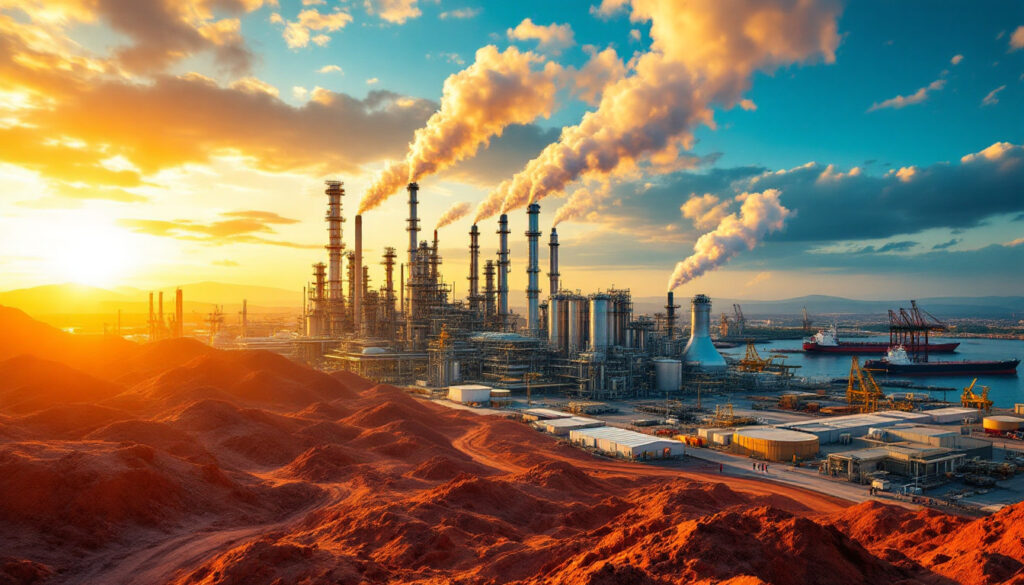What is the Fastmarkets Bauxite & Alumina Conference?
The Fastmarkets Bauxite & Alumina Conference stands as the aluminum industry's premier gathering, scheduled for April 2-4, 2025, in Miami, Florida. This annual event brings together the global value chain's most influential stakeholders—producers, traders, consumers, and market analysts—creating an unparalleled networking opportunity for industry professionals seeking to navigate the complex bauxite and alumina landscape.
Since its inception, the conference has evolved into a crucial platform where market participants debate industry challenges, share insights, and form strategic partnerships. The 2025 fastmarkets bauxite and alumina conference in miami comes at a particularly pivotal moment as the market grapples with significant price volatility, shifting production centers, and mounting geopolitical tensions affecting trade flows.
What distinguishes this event from other industry gatherings is its comprehensive approach to the entire value chain, from mining operations to refineries and smelters. Attendees gain exclusive access to Fastmarkets' proprietary data and analysis, including their newly launched indices for non-Australian markets, providing crucial benchmarking tools for contract negotiations and strategy development.
For companies navigating bauxite supply security concerns or seeking to capitalize on evolving alumina trade patterns, the conference offers direct engagement with decision-makers across the supply chain. This face-to-face interaction proves invaluable in an industry where relationships and market intelligence directly impact operational success.
How Has the Alumina Market Performed Recently?
The alumina market has experienced extraordinary volatility over the past year, with prices reaching an unprecedented peak of $805.83 per tonne on December 4, 2024—a level that sent shockwaves through the aluminum value chain. This historic high represented the culmination of severe supply constraints coupled with robust demand fundamentals that created a perfect storm in the market.
However, 2025 has witnessed a dramatic reversal, with prices plummeting 42.1% from $670.98 per tonne at the beginning of the year. This rapid descent reflects the market's transition from acute shortage to emerging surplus, fundamentally altering the supply-demand balance that had previously supported record valuations.
Several factors have contributed to this dramatic shift. Supply-side pressures that characterized 2024—including production disruptions at major Australian refineries and logistics challenges in Guinea's bauxite sector—have largely subsided. Simultaneously, consumer demand has softened amid global economic uncertainties and inventory destocking.
Perhaps most significantly, the market has seen an unprecedented influx of non-traditional supply sources. Vietnamese, Indian, and Indonesian alumina—regions previously considered marginal suppliers—have flooded the spot market, challenging Australia's historically dominant position. A senior producer source noted, "Profit margins for aluminum production are significantly better now compared to when alumina prices were at their record high, creating breathing room for smelters that were previously operating at minimal profitability."
The industry now faces the challenge of absorbing this surplus capacity, with many analysts suggesting prices may need to fall further before finding equilibrium. This situation represents a stark contrast to just months ago when consumers were scrambling to secure material at almost any price.
What Expansion Projects Are Reshaping the Global Supply Landscape?
The global bauxite and alumina production landscape is undergoing a fundamental transformation, with Western Australia's long-standing dominance increasingly challenged by ambitious expansion projects across Asia. This geographical diversification represents one of the most significant structural shifts in the industry's recent history.
In India, Vedanta's Lanjigarh refinery expansion stands as a testament to the country's growing ambitions in the sector. The project targets an impressive 5 million tonnes per year (tpy) capacity, positioning India's national critical mineral mission as an increasingly significant player in global alumina production. This expansion comes amid India's broader push to develop downstream aluminum capacity to support its rapidly growing manufacturing sector.
Indonesia has emerged as perhaps the most aggressive new entrant in the market, with multiple large-scale projects under development. PT Borneo Alumina Indonesia's SGAR operation exemplifies this ambition, targeting initial production of 1 million tonnes in 2025 before expanding to 2 million tpy. Complementing this are PT Dinamika Sejahtera Mandiri's 2 million tpy facility and PT Quality Sukses Sejahtera's 1.5 million tpy operation—collectively representing a transformative addition to global capacity.
Vietnam's emergence as a potential alumina powerhouse has perhaps been the market's most unexpected development. Vincamonim's substantial $7.3 billion investment signals the country's serious intentions to establish a fully integrated aluminum industry, leveraging its relatively untapped bauxite reserves.
In response to this evolving production landscape, Fastmarkets has strategically launched three new inferred indices specifically designed to track non-Australian markets. This development reflects the growing importance of these alternative supply sources and provides crucial price transparency for market participants navigating this changing environment.
The environmental implications of these projects vary significantly across jurisdictions. While Australian production operates under stringent sustainability guidelines, emerging producers face varying regulatory frameworks, creating potential competitive advantages but raising concerns about global emissions standards in production.
Why is Bauxite Supply Security a Critical Industry Concern?
Guinea's dominance in global bauxite reserves represents one of the most significant supply security challenges facing the aluminum industry. With an estimated 7.3 billion tonnes of bauxite reserves—the world's largest by a substantial margin—Guinea's political stability directly impacts the entire aluminum value chain from mining through refining to smelting.
The market experienced this vulnerability firsthand when Guinea banned Emirates Global Aluminium (EGA) from exporting bauxite in late 2024, triggering immediate supply anxiety and price volatility. The impact was swift and severe: prices jumped 20.25% month-on-month to $90-100 per dry metric tonne (dmt) in November 2024 before reaching an all-time high of $115-130 per dmt in January 2025.
Political instability has been a persistent concern since the September 2021 coup d'état, which ousted President Alpha Condé and installed a military government under Colonel Mamady Doumbouya. The junta's approach to resource nationalism and mining contracts has created an unpredictable operating environment for international mining companies, which must navigate complex relationships with the transitional government.
What makes this situation particularly problematic is the quality of Guinean bauxite. Its high alumina content and low reactive silica make it ideal for refining, with few global alternatives matching its metallurgical characteristics. Australian bauxite, while more politically secure, often contains higher silica levels, requiring more energy-intensive processing.
The industry is actively exploring alternatives to reduce dependency on Guinean supply. Countries like Vietnam and Indonesia are accelerating bauxite projects, but questions remain about ore quality and extraction costs. The development of more advanced processing technologies capable of utilizing lower-grade bauxite economically represents another potential long-term solution, though such innovations remain years from commercial viability.
For aluminum producers, this situation necessitates sophisticated risk management strategies, including diversified supply chains, long-term contracts with multiple producers, and potentially vertical integration through direct investment in mining operations to secure access to this critical raw material.
How Are Declining Alumina Prices Affecting the Aluminum Industry?
The sharp decline in alumina prices has created a complex ripple effect throughout the aluminum value chain, with divergent impacts across different market segments. For primary aluminum producers, the situation has significantly improved profit margins compared to the challenging environment of record-high alumina prices in late 2024.
With alumina typically representing approximately 30-40% of aluminum production costs, the substantial price decline provides welcome relief for smelters that had been operating with compressed margins. This improvement comes at a critical time for many operations that had been contemplating curtailments during the peak of input cost pressures.
Paradoxically, this cost relief hasn't translated to stronger aluminum premiums. The European market has witnessed a particularly dramatic decline, with the Aluminum P1020A premium, in-warehouse Rotterdam dropping from $340-370 per tonne in December 2024 to just $190-220 per tonne by March 2025. This disconnect highlights how aluminum pricing remains driven by a complex interplay of factors beyond raw material costs.
A significant development influencing this dynamic has been the shift in the London Metal Exchange (LME) cash/three-month spread, which has moved from backwardation into contango. As one European trader observed, "The fortune could turn around with spreads moving into contango and attracting metal into LME warehouses." This structural market change encourages stockholding rather than immediate sales, potentially tightening physical availability despite improved production economics.
For downstream fabricators and end-users, the situation creates a more favorable purchasing environment, though demand remains constrained by broader economic factors rather than simply input costs. Construction and automotive sectors—key aluminum consumers—continue to show muted activity despite the more attractive pricing environment.
The relationship between alumina costs and aluminum premiums underscores the market's complexity. While direct causality might suggest lower input costs should lead to lower aluminum prices, market participants recognize that inventory levels, financing costs, and physical logistics often exert greater influence on short-term premium movements than production costs alone.
What Geopolitical Factors Are Influencing the Market?
Geopolitical tensions have emerged as perhaps the most significant exogenous factor influencing the bauxite and alumina markets, with trade policy changes and regional conflicts creating unprecedented market disruptions. The Trump administration's trade policies reshaping commodity markets through implementation of 25% tariffs on all US imported aluminum represents the most direct and consequential intervention.
The impact of these tariffs has been immediate and substantial, triggering a 71.1% increase in the aluminum P1020A premium, delivered duty-paid Midwest US, which surged from 22-23 cents per pound to 37-40 cents per pound. This dramatic price movement underscores how policy decisions can rapidly transform market fundamentals independent of supply-demand dynamics.
While these tariffs directly target aluminum, their indirect effects on the alumina market have been significant. Trade flows have adjusted as producers recalibrate their export strategies, with some redirecting material to non-tariffed markets while others absorb the duties to maintain customer relationships. This reshuffling creates both challenges and opportunities across the value chain.
Market participants remain vigilant regarding potential additional announcements from the Trump administration, particularly around the symbolically significant April 2 "Liberation Day." As one European trader noted, "With Trump, you can never predict what announcements might come next." This policy uncertainty adds a premium to risk management strategies throughout the industry.
Concurrently, developments in the Russia-Ukraine conflict continue to influence market dynamics, particularly regarding Russian aluminum sanctions. The European Union's declining imports of Russian unwrought aluminum—from over 100,000 tonnes in March 2022 to approximately 20,000 tonnes by December 2024—illustrate how geopolitical tensions can fundamentally alter established trade patterns.
The implementation of the EU's Carbon Border Adjustment Mechanism (CBAM) adds another layer of complexity, effectively creating a carbon-based tariff system that disproportionately impacts producers with carbon-intensive operations. Russian aluminum, with its high carbon footprint from coal-powered smelters, faces particular challenges under this regime, potentially accelerating the decline in EU imports beyond direct sanctions effects.
For market participants, navigating this complex geopolitical landscape requires sophisticated scenario planning and flexible supply chain strategies. The ability to quickly pivot between sourcing options and adjust pricing models to incorporate geopolitical risk premiums has become a competitive differentiator in this volatile environment.
How Are New Technologies and Sustainability Initiatives Affecting the Industry?
The bauxite and alumina industry stands at a technological crossroads, with sustainability imperatives driving unprecedented innovation across the value chain. Perhaps most emblematic of this push for alternative sourcing solutions is the European Space Agency's groundbreaking research into lunar regolith as a potential critical minerals alternative—an initiative that, while futuristic, underscores the urgency of developing new resource pathways.
More immediate technological advancements are transforming conventional production methods. Modified Bayer process technologies are enabling refineries to process previously uneconomical bauxite grades with higher silica content, potentially expanding the viable resource base beyond traditional high-grade deposits. These adaptations are particularly significant given the industry's increasing concerns about supply concentration in politically volatile regions.
Sustainability challenges within the alumina refining process center primarily on the management of red mud, the caustic byproduct generated during bauxite processing. Innovative approaches to red mud valorization are gaining traction, with companies developing methods to extract additional value from this waste stream. Technologies that can recover rare earth elements, iron ore, or utilize red mud in construction materials represent both environmental and economic opportunities.
The circular economy represents another frontier transforming industry dynamics. Enhanced aluminum recycling technologies are steadily improving the quality and applicability of secondary aluminum, reducing the demand for primary production. Current global recycling rates approaching 75% for aluminum beverage cans highlight the potential for closed-loop systems, though challenges remain in segregating alloys and managing contamination.
Environmental regulations, particularly those targeting carbon emissions, are reshaping production economics across regions. The EU's CBAM implementation creates tangible financial incentives for lower-carbon production methods, while consumer-facing companies increasingly demand low-carbon aluminum for their products. This pressure has accelerated investment in technologies like inert anode cells and renewable energy integration at refineries and smelters.
The industry's drive toward improved energy efficiency extends beyond regulatory compliance to economic necessity. With energy typically representing 30-40% of alumina refining costs, technologies that reduce consumption directly improve competitiveness. Heat recovery systems, process optimization through advanced analytics, and alternative energy sources are becoming standard features in new facilities and retrofits alike.
These technological and sustainability initiatives collectively represent not merely incremental improvements but fundamental shifts in how the industry operates. Companies that successfully integrate these innovations gain both regulatory advantages and improved cost positions, potentially reshaping competitive dynamics across the aluminum value chain.
What Are the Key Market Indicators to Watch?
For market participants navigating the volatile bauxite and alumina landscape, identifying and monitoring the right indicators is essential for anticipating market movements and making informed decisions. Price trends across the value chain—from bauxite through alumina to aluminum—provide the most direct barometer of market conditions, with particular attention warranted for divergences between these historically correlated commodities.
Regional premium differentials offer perhaps the most nuanced insights into market dynamics. The growing spread between US Midwest and European Rotterdam premiums—driven by tariff differentials and varying demand conditions—creates both challenges and arbitrage opportunities for global traders. These premium variations often serve as leading indicators for physical market tightness before appearing in broader indices.
Trade flow shifts resulting from geopolitical tensions represent another critical indicator category. Customs data revealing changes in bauxite shipments from Guinea or alumina exports from Australia can provide early warning of supply disruptions or market rebalancing. Similarly, changes in Chinese import patterns often precede global price movements given China's outsized influence on commodity markets.
Supply-demand balance forecasts for 2025-2026 suggest continued volatility. Current projections indicate potential alumina surplus through mid-2025 before tightening toward year-end as Indonesian capacity ramps up more slowly than initially projected. These forecasts require constant adjustment as new capacity commissioning dates shift and demand patterns evolve.
The Carbon Border Adjustment Mechanism (CBAM) implementation timeline creates another set of critical indicators. As reporting requirements transition to actual financial obligations, the resulting cost impacts will vary dramatically across production sources. Tracking differential carbon costs between Russian, Middle Eastern, and Western aluminum will become essential for understanding competitiveness in European markets.
Energy price differentials between production regions increasingly influence aluminum cost curves, with natural gas prices in Europe and coal costs in China serving as proxies for production cost competitiveness. The growing gap between regions with access to low-cost renewable energy and those dependent on fossil fuels creates structural advantages that manifest in long-term investment decisions.
For those seeking leading indicators of market sentiment, LME warehouse stock movements—particularly warrant cancellations and location shifts—often precede physical market tightness. Similarly, changes in Chinese production operating rates, visible through satellite monitoring of smelter heat signatures, provide real-time insights into the world's largest aluminum market before official statistics become available.
FAQs About the Bauxite and Alumina Markets
What factors are driving the shift in global bauxite and alumina production?
The migration of production capacity from traditional centers like Australia toward emerging producers in Indonesia, India, and Vietnam stems from a convergence of factors. Resource nationalism in Guinea has heightened supply security concerns, while Indonesia's ban on raw bauxite exports has accelerated domestic refining investments. Simultaneously, cost advantages in energy-efficient new facilities and proximity to growing Asian aluminum demand create compelling economics for green aluminium initiative in Australia and other greenfield projects outside established production centers.
How will US tariffs affect global aluminum and alumina trade flows?
The 25% US tariffs are triggering complex trade flow adjustments across the value chain. While directly targeting aluminum, these measures indirectly influence alumina markets by altering smelter economics. Canadian and Mexican aluminum producers—exempt from tariffs under USMCA—gain competitive advantages in the US market, potentially increasing their alumina consumption. Meanwhile, displaced material from other producers seeks alternative markets, creating cascading effects on regional premiums globally and potentially depressing prices in non-US markets as supply is redirected.
What is the outlook for alumina prices in the remainder of 2025?
Alumina prices face continued downward pressure through mid-2025 as surplus capacity from Indonesian and Vietnamese projects enters the market. Industry forecasts suggest prices may find support in the $200-250 per tonne range by Q3 as high-cost Western producers potentially curtail output in response to compressed margins. However, price recovery depends significantly on aluminum demand growth resuming, particularly in China's construction and automotive sectors, which remain subdued ami
Ready to Gain an Edge on ASX Discovery Stocks?
Discover significant mineral announcements as they happen with Discovery Alert's proprietary Discovery IQ model, providing instant notifications on high-potential ASX discoveries. Visit our discoveries page to see how major mineral discoveries have historically delivered exceptional returns and start your 30-day free trial today.




